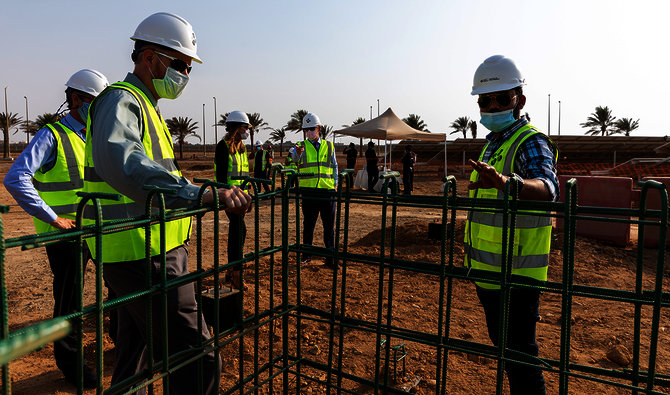JEDDAH: Seven megastars closed the Jeddah Season with a bang for 20,000 avid music lovers on Thursday.
The Jeddah Music Festival attracted Saudis from around the Kingdom.
The audience filled King Abdullah Sports City despite the heat, but nothing could prepare them for what was to come.
R3wire and Varski appeared on stage and cheers erupted from the crowd. The latter hyped them up in anticipation for the concert.
#LIVE: What a set from @IAMREWIRE and @VARSKI - Jeddah crowd now buzzing for the arrival of @JanetJackson at #JeddahWorldFest#SaudiArabia (@JED_SEASON)https://t.co/hYaEot935X pic.twitter.com/tAXA6dqHOQ
— Arab News (@arabnews) July 18, 2019
The pair played remixes of songs like “We Will Rock You” by Queen and The White Stripes’ “Seven Nation Army” before mixing “One Kiss” by Dua Lipa and Calvin Harris.
“Jeddah World Fest in Saudi Arabia was so special! Words cannot describe the love in the air,” R3wire posted on Facebook.
Once the DJs set the mood for the evening, superstar singer Janet Jackson stormed onto the stage. She sang and danced to hits like “All For You” and her latest track “Made for Now,” stealing the audience’s breath with every kiss she blew their way.
After her powerful performance, she was replaced by English heart-throb Liam Payne. Once a part of One Direction, Payne is now a solo artist.
He performed a mix of songs, showing his vocal range and inspiring the crowd to sway with him when he sang “Drag Me Down” and a cover of “Shape of You” by Ed Sheeran.
“The crowd here in Jeddah is amazing,” he said while performing. “I want to say something really important: Music unites us, and it’s good to be here with you tonight.”
After a short intermission, American rapper Tyga delivered his second performance in Jeddah after his debut on July 12.
The audience was waiting especially for him, and when he appeared on stage people made sure to show the rapper all their love with loud cheers.
Tyga performed some of the fans’ favorite tracks, including “Ice Cream Man”, “Taste”, “Rock City” and “Hookah.”
Without a moment’s rest, rapper Future began to spit fire on the stage as soon as Tyga stepped off. The rapper, 35, performed some of his famous tracks like “Jumpman”, “Low Life” and “Mask Off.”
Legendary rapper 50 Cent then transported the audience to the early 2000s as he performed his tracks “P.I.M.P” and “Candy Shop” before the crowd exploded with energy when the intro to “In Da Club” began to play.
#LIVE: American rapper @50cent performing at #JeddahWorldFest #SaudiArabia
(@JED_SEASON)https://t.co/hYaEosRrHn pic.twitter.com/hawjAtmXAd— Arab News (@arabnews) July 19, 2019
At one point, he asked the crowd to chant his name, before telling them to start calling him 50 Halalas instead, the equivalent to cent in Saudi Arabia.
He later tweeted: “My new name is 50 HALALA, so get with the program. I might move out here I like it.”
Rsha Khan, 27, who attended the concert with her family, told Arab News: “We enjoyed 50 Cent the most because he sang his old songs. It was fun to see as most people started singing along with him and jumping out of excitement.”
Although Chris Brown’s time on stage was short-lived and bittersweet, with the singer only performing four tracks, fans still swayed to the rhythm of his huge hit “Loyal” featuring Lil Wayne and Tyga.
#LIVE: Singer-songwriter Chris Brown on stage at #JeddahWorldFest #SaudiArabia (@JED_SEASON)https://t.co/hYaEosRrHn pic.twitter.com/5VbQeRpnXQ
— Arab News (@arabnews) July 19, 2019
Lastly, legendary DJ and producer Steve Aoki flew in all the way from Mykonos, Greece to set the stage alight with an immense set-list.
The crowd jumped and surged to the beat of his opening track, “Moshi Moshi,” before moving to another classic, “Bella Ciao.”
Even though members of the crowd were exhausted after being at the venue for seven hours, their energy was refueled as Aoki hyped them up with his high-octane performance with songs like “Rave” forcing the crowd to jump in unison.
Aoki created a brand new track with Saudi singer Dalia Mubarak especially for the concert just 24 hours before he arrived on stage. The song had a mixture of Egyptian and Gulf undertones, and while Mubarak’s strong vocals carried through the air, Aoki danced by her side.
“I’m very grateful to be here, I have a feeling I have a lot of fans here in Saudi Arabia,” he told the beaming crowd who had waited until the early hours of the morning to see him.
The international DJ addressed all segments of the audience, playing two of his tracks featuring K-pop artists like Monsta X and BTS. He made sure to return the love he felt from the Saudis by remixing two special new tracks for the Jeddah World Festival, including a mix of Egypt’s beloved singer Abdel Halim Hafez and his BTS mix with MIC DROP.
The festival allowed attendees to not only enjoy the performers they were anticipating but also discover new music. Khan did not know Steve Aoki until Friday. She said: “He was amazing, it was the first time we heard his music and instantly I loved it! He hyped up the crowd with his powerful music. He should have been one of the first performers because by the time he came up people were so tired, but he still made everyone dance.”
Some of the audience struggled with the heat. Sara Manzar, who was attending with her younger brother, said: “The festival was good, I enjoyed 50 Cent and Steve Aoki the most but it would have been better if there were fans or air conditioners around the area because the weather was too hot.”
Dina Ajjaj, 18, who was attending the show with her mother, said: “I really enjoyed the festival despite the weather. The stars that came made this night perfect. I loved Steve Aoki the most, it was the best part of the night! I’m looking forward to attending next year.”
Raneem Has Ibrahim, 30, thought that the event was organized smoothly. “The stadium was close to everyone, and the gates were very well-organized. The assistants were very helpful and in good spirits despite the pressure. It was comforting to see security and ambulances around if people needed them,” she told Arab News.
“The concert itself was fire,” Ibrahim added. “It exceeded expectations and I’m so happy that we’re attending international concerts like this in Jeddah.”
Jeddah Season is part of the Saudi Season project to showcase and promote the Kingdom’s cities as major tourist destinations, and to encourage partnerships with local businesses.
The 41-day festival included over 150 events and activities featuring local, regional and international acts.








































